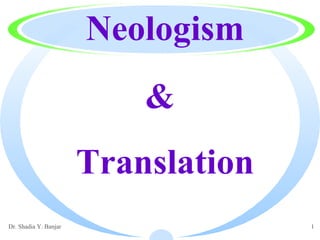
Neologisms
- 2. What is neologism? The lexicographic term " neologism " is in itself something of a neologism. For a long time neologism was mainly seen as pathological or deviating - Webster’s Third New International Dictionary (1966) describes neologism as "a meaningless word coined by a psychotic" - and such linguistic standard works as Bloomfield´s Language or Lyons’ Semantics do not index the term. [ Rey (1995:63)]
- 6. Neologisms can be either loan words in the form of direct loans and loan translations, or newly coined terms, either morphologically new words or by giving existing words a new semantic content.
- 7. For the individual, some words may be unknown without necessarily being neologisms. A special term that the interpreter does not understand is not automatically a neologism. It is part of the linguistic competence and general knowledge of the interpreter that s/he is able to determine whether a term is "new" or just unknown to him-/herself.
- 8. Neologisms have to become generally known to the public through their usage in a specific context.
- 14. The phenomenon of collocation means that two (or sometimes more) words appear in each other's company because the usage of a particular word (for example a noun) limits the choice of an adjective to a small number of adjectives that can combine with this particular noun. The same can count for a noun and a verb.
- 15. One might say there is a core word (the word that comes to the mind first) and a collocator that combines with that core-word. One has for example in mind the noun 'crime' in English, and looks for the verb which combines with it, and which denotes the action of 'doing it' (the crime). This has to be either the verb 'commit' or 'perpetrate'.
- 16. This applies for Arabic as well. When having the noun جريمة in mind, only the verbs ارتكب or اقترف can be used. While still having the same noun in mind and seeking for an adjective that expresses the bad, violent and harmful nature of the crime one can in English choose from a limited number of adjectives like 'atrocious','vicious' and some others. The same in Arabic; with جريمة one can combine a limited number of adjectives like نكراء .
- 17. Collocations (also called recurrent combinations or fixed combinations) are specific combinations of for example a noun and an adjective, or a noun and a verb. In a bilingual context collocations are very important for learners of a language. Usage of the right combinations, being a part of style, results in correct language production at least at this stylistic level.
- 18. Classification of types of collocations The following classification of collocations was published by Peter Emery in ZA (Emery, Peter G.: Collocation in Modern Standard Arabic. In: Zeitschrift für arabische Linguistik 23 (1991))
- 19. a) Open collocations : combinations of two or more words co-occurring together, without any specific relation between those two words. Combinations in which both elements are freely recombinable. Each element is used in a common literal sense. examples given by Emery: انتهت الحرب , بدأت الحرب
- 20. b) Restricted collocations : combinations of two or more words used in one of their regular, non-idiomatic meanings, following certain structural patterns, and restricted in their commutability not only by grammatical and semantical valency, but also by usage. examples from Emery: حرب ضارّة , جريمة نكراء examples from our corpus: أحرز تقدما , خسارات جسمية
- 21. c) Bound collocations : a bridge category between collocations and idioms. One of the elements is uniquely selective of the other. example by Emery: أطرق الرأس d) Idioms : the constituent elements of idioms are opaque, i.e. used in 'specialized' senses, together forming a single semantic unit.
- 22. Restricted collocations cause problems when it comes to production in the foreign language. Obviously open collocations do not deserve special attention from the teacher's or translator's point of view. Bound collocations , as marking a transitional stage, seem interesting from a linguistic scientific point of view, but rather limited in occurrence. Idioms are of interest to anyone but should be studied separately.
- 23. A collocation in L1 will very often not be equal in L2. Heliel (Mohamed Hilmi Heliel: Collocations and Translation. In: Proceedings of the FIT Round Table 'Professional Arabic Translation and New Technologies ', Tanger june 1989) gives the example of seven collocations with the English adjective ' heavy ' that should in Arabic be translated with seven different adjectives. Heavy rainfall, fog, sleep, seas, meal, smoker, industry are translated in Arabic as مطر غزير , ضباب كثيف , سبات عميق , بحار هائجة , وجبة دسمة , مدخن مفرط , صناعة ثقيلة .
